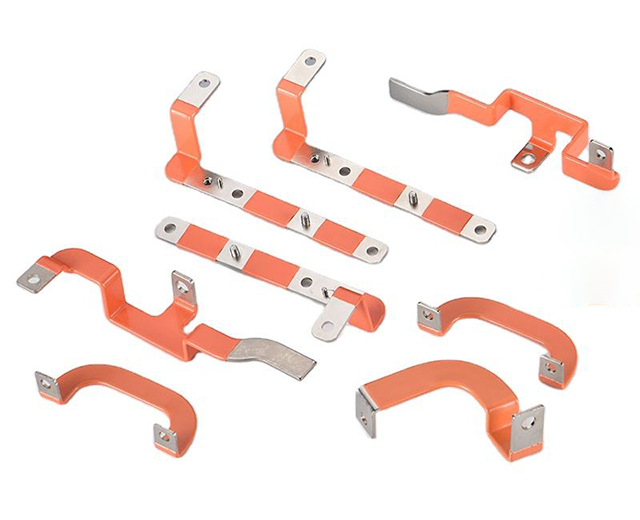

Busbar Systems are essential components in modern power distribution networks. A busbar system provides a reliable, efficient, and safe solution for carrying and distributing high current from power sources to various electrical devices. Compared with traditional cable wiring, busbars offer superior conductivity, reduced energy loss, better heat dissipation, and a more compact structural layout.
Busbars are typically made from Copper (Copper Busbar / Solid Copper Busbar / Flexible Copper Busbar) or Aluminum (Aluminum Busbar / Flexible Aluminum Busbar) depending on current capacity, system design, and budget requirements.
Our factory specializes in the design, manufacturing, machining, plating, insulation coating, and customized assembly of Busbar Systems for industrial, commercial, automotive, rail transit, renewable energy, and data center applications.

A Busbar System is an integrated conductor network used to collect power from input terminals and efficiently distribute it to output circuits.
It can include:
Conductive Busbars (Copper / Aluminum)
Flexible Busbars (Laminated or Braided)
Insulation Layers (PVC, Heat-Shrink, Epoxy Coating)
Busbar Support Insulators & Mounting Hardware
Connectors / Terminals / Fastening Components
The structure is designed to handle high current load while maintaining mechanical stability and electrical safety.
| Component | Material / Type | Function |
|---|---|---|
| Conductor Body | Solid Copper Busbar / Aluminum Busbar / Flexible Busbar | Transfers and distributes current |
| Surface Treatment | Tin / Nickel / Silver Plating | Anti-oxidation, low contact resistance |
| Insulation | Epoxy Coating / PVC Heat Shrink / Rubber | Prevents short circuits and ensures safety |
| Support Insulator | Ceramic / Composite Resin | Isolates busbars from grounding and vibration |
| Connectors | Copper / Stainless Steel | Fixes busbars to electrical terminals |
Made from T2/C1100 Copper or 1060/6061 Aluminum
Rigid, high current capacity
Used in power distribution cabinets, switchgear rooms
Laminated layers or braided copper/aluminum strips
Absorbs vibration & thermal expansion
Ideal for battery energy storage systems (BESS), electric vehicles, transformers
Highest conductivity (up to 99.9% IACS)
Used in high-performance, compact electrical systems
Cost-effective and lightweight alternative
Used in large-scale renewable power systems
| Advantage | Description |
|---|---|
| High Conductivity | Ensures efficient current distribution with minimal energy loss |
| Compact Structural Design | Saves space in electrical cabinets and systems |
| Better Heat Dissipation | Flat and wide structure increases cooling efficiency |
| Reduced Installation Time | Busbar systems are faster and easier to install than cable networks |
| Improved System Reliability | Stable mechanical performance with no loose cable strands |
| Supports Custom Shapes | CNC bending, stamping, drilling available for OEM design integration |
| Safety & Insulation | Available with Insulated Busbars to prevent accidental contact |
Our Busbar Systems are widely used in:
Power Distribution Cabinets & Switchgear
Industrial Automation Systems
UPS & Data Center Backup Systems
Solar PV Inverters & Energy Storage Batteries
EV Powertrain & Battery Pack Busbar
Marine and Railway Electrical Systems
Wind / Solar Renewable Power Plants
HVAC and Building Electrical Distribution
Copper: T2, C1100, C1020 (High Conductivity)
Aluminum: 1060, 3003, 6061 (Lightweight Options)
CNC Cutting / Stamping
Precision Bending & Forming
Punching & Slotting
Welding & Brazing
Tin / Nickel / Silver Plating
Epoxy Insulation Coating or Heat-Shrink Insulation
Flat
Bent (L, U, S, Z shapes)
Laminated Flexible Structure
Braided Soft Connectors
Over 15+ years manufacturing experience
OEM & ODM Design Service
Strong R&D Engineering Support
ISO Quality-Controlled Production
Direct Factory Pricing
Stable Global Supply Chain Delivery
We supply to:
| Industry | Region |
|---|---|
| Power & Energy | Asia, Europe, Middle East |
| Data Centers | North America, EU |
| Renewable Energy & ESS | Southeast Asia, South America |
| Automotive & Rail Transit | Global Tier Suppliers |
Copper Busbar has higher conductivity, better mechanical strength, and lower resistance loss.
Aluminum Busbar is lightweight and cost-effective but requires a larger cross section to carry the same current.
Rule of Thumb:
1 mm² Copper ≈ 1.6 mm² Aluminum (Current capacity equivalence)
Determine rated current
Check voltage drop & temperature rise limits
Select cross section from current capacity table
Apply correction factors for installation environment (heat, airflow, insulation)
We can calculate for you if you provide:
Current (A)
Voltage (V)
Installation environment
Expected continuous operation hours
Yes — we support OEM / ODM.
Available processing:
CNC Cutting
Laser Profiling
Bending (L, U, Z, S shapes)
Punching / Drilling
Laminated bonding
Welding & Capping
Simply provide: Drawing / CAD / Sample / Technical Requirements
Yes — we offer:
PVC / PE extrusion insulation
Epoxy resin coating insulation
Heat-shrink insulation
Custom color marking for polarity (+/-)
Standard sizes: 3–7 days
Customized shapes: 7–20 days
High-volume OEM: Negotiable based on schedule
UPS & Data Centers
Solar & Energy Storage (ESS)
Electric Vehicles and Battery Packs
Power Distribution Cabinets
Industrial Automation
Telecom Power Supply
Rail & Marine